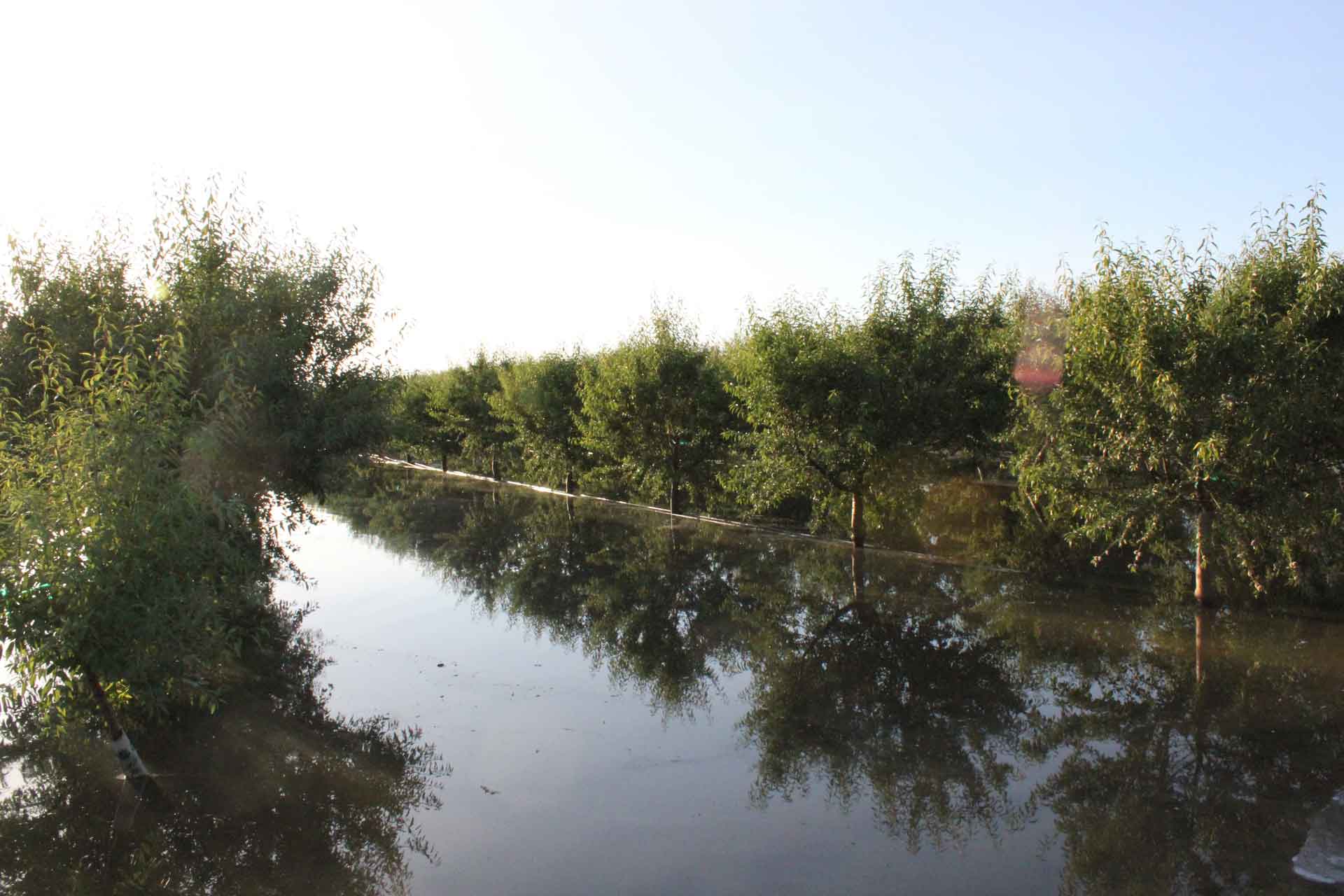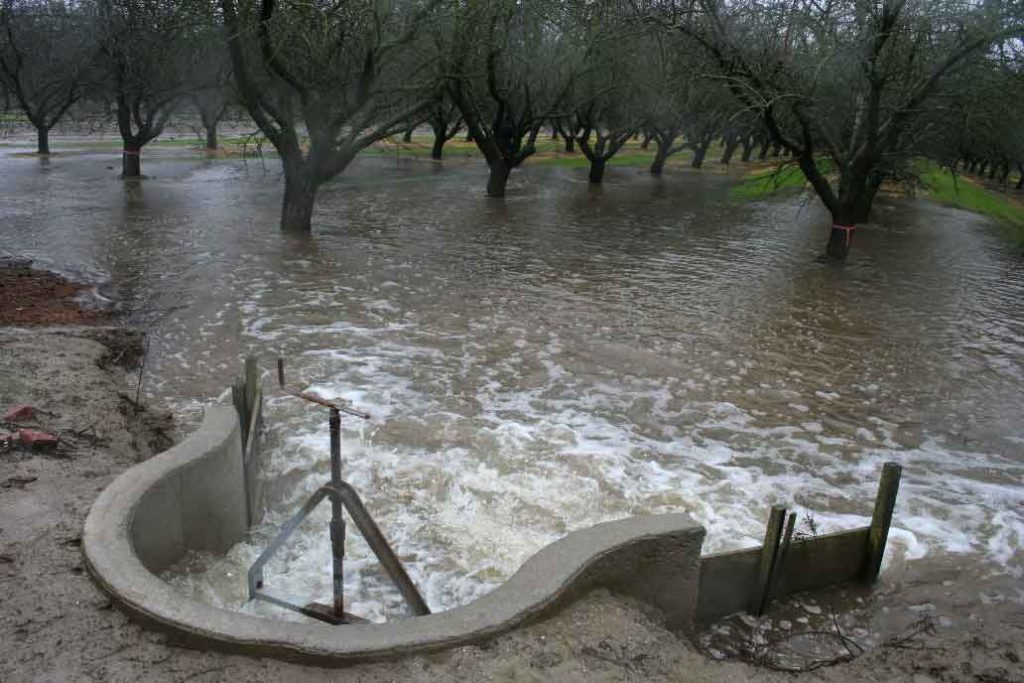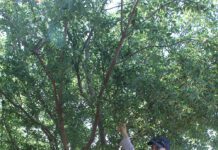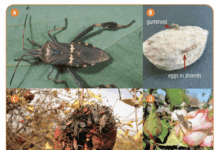
Results of a three-year study of almond orchards used for groundwater recharge not only revealed few issues with tree health, it measured the amount of water added to the water table. Researchers looked at effects on tree health, as well as how much water was sent below the root zone.
Groundwater recharge is one of the avenues available to the agriculture industry to reverse overdraft of groundwater in basins underlying the Central Valley. With the Sustainable Groundwater Management Act (SGMA) aimed at balancing extraction with replenishment, interest in groundwater recharge ability has grown.
Flooding Orchards
Flooding almond orchards during the dormant season could help accelerate natural groundwater recharging of aquifers, University of California (UC) researchers believe, but concerns about long term tree health are also being addressed in the study.
“With careful attention to soil suitability and with appropriate access to water and infrastructure,” said Gabriele Ludwig, director for Sustainability and Environmental Affairs, Almond Board of California (ABC), “almond growers have an opportunity to play a role in groundwater recharge.”
Groundwater Recharge Research
Helen Dahlke, a professor of Integrated Hydrologic Sciences at UC Davis, and one of the lead researchers in the study said the three study sites, in Modesto, Denair and Orland had different ratings for soil infiltration capacity. The ratings were based on the Soil Agricultural Groundwater Banking Index (SAGBI), an online tool developed by UC Cooperative Extension soil specialist Toby O’Geen. The SAGBI uses soil characteristics to determine suitability for groundwater recharge. The index takes into account hydraulic conductivity, occurrence of water restrictive layers, topographical limitations (slope) chemical limitations and surface conditions.
Orchard sites best suited for groundwater recharge have high saturated hydraulic connectivity, soils that are not prone to forming crusts, flat surfaces and with soils naturally low in salt content or other chemicals that can contaminate groundwater.
There are pockets in the groundwater system where water can be pumped out easily, Dahlke noted in a UC Water News report, and then there are pockets where it is really hard to get the water out. Those are typically areas where there are a lot of fine materials that don’t allow quick conveyance of that water to a groundwater well.
Dahlke said the Delhi site proved to be excellent for recharge capability. The study found that the orchard’s sandy soil allowed for 93-99 percent of the 24 inches of applied water each year for two years to move past the root zone.
The Modesto orchard site was rated moderate for groundwater recharge capability. The orchard site had fine sandy loam soils, but variability in soil texture and layering complicated the downward movement of water. The estimate for water movement over two winters was 81-96 percent of the water moving below the root zone. The variation, Dahlke said, was due to water used to bring the soil to field capacity.
The Orland site proved to have a moderate to poor recharge capability, mainly due to already saturated soils.
Contaminants, including nitrate, leaching into the water table with recharge efforts is a concern, Dahlke said. They did see some leaching during the study, but with the amount of water being pushed through the root zone, there was dilution. There was an 84 percent reduction in residual soil nitrate following the recharge study.
The goal of the study, which was also funded by UC ANR, was to look into surface water availability for groundwater recharge. The state department of Water Resources also has a report, the Water Available for Replenishment (www.water..ca.gov/groundwater/sgm/wadr.cfm) that has information on the amount of surface water available.
According to the organization Sustainable Conservation, California’s groundwater storage capacity is more than 10 x that of surface storage. In normal rainfall years, about 30 percent of the state’s water supply is pumped from the ground. That percentage rises to 60 during drought years. Increased groundwater pumping to compensate for lack of surface water deliveries has caused decline of water tables in many basins.
Capturing Runoff
In a UC Water Security and Sustainability Research Initiative report, Dahlke said that in order for on-farm recharge to be a long term endeavor, a number of factors are necessary: location, soil, and crop capability are important. There also has to be excess surface water nearby.
Dahlke said that a lot of stream runoff is generated in the Central Valley on ag lands that is contributing to stream flow. How much water is running off the surface during big storm events is underestimated, she said. Much of that water could be captured with better management.
Trees planted on well-drained soils, researchers said, were not adversely affected by flooding during dormancy. Effects of flooding during the growing season will be studied next.
Tree Health
Astrid Volder, a professor in the department of Plant Sciences at UC Davis who has been monitoring tree health in this study, said to date no negative effects on the trees have been observed.
The Delhi-site trees, growing in sandy soil, remained more hydrated during the growing season. And their roots showed a 30–70 percent longer lifespan than the control group—possibly because flooding flushed harmful salts and nitrates from the root zone.
Volder said the recharge in the winter occurs during dormancy and trees can handle the additional water. The orchards in the study will continue to be monitored for lingering effects on root health, but Volder said as long as the recharge is done during the winter months, no negative effects are expected.
As groundwater sustainability plans move forward, the almond industry study can play a part in answering recharge questions.
“Under SGMA, there are really just two levers you can pull to achieve a groundwater balance—reduce the amount you take out of the ground, or put more water in. If you lean on the former, you cause a fair amount of pain. Recharge is the more optimistic and visionary way of achieving sustainability,” said, Jesse Roseman, senior specialist for Environmental and Regulatory Affairs at ABC.












